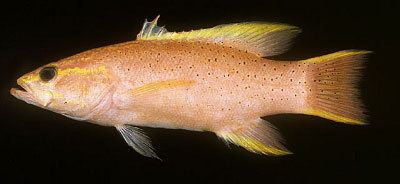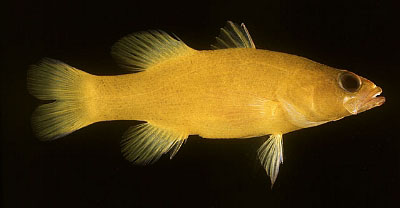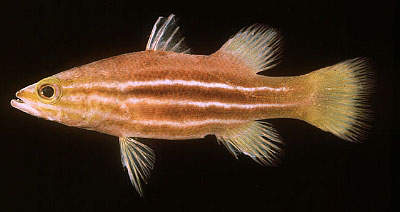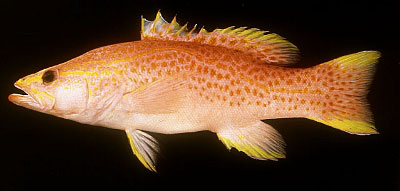|
They
are hard to acquire, fairly expensive, and often reclusive.
Additionally, they can put diminutive fishes and ornamental
shrimps at risk of hostile attacks. So why is it that fish
of the genus Liopropoma are highly sought after by
seasoned aquarists? Their remarkable and beautiful coloration
is one reason; their incredibly peaceful persona (except towards
small fish and shrimp) is another. Finally, the irregularity
with which they are collected and imported into the aquarium
trade ensures that they remain eclectic additions for most
aquarists. With the onset of September let me introduce the
reef fish collectively known as Cave Basses.
|
For all intents and purposes, this is THE fish of the
genus. The Peppermint Bass, more accurately known as
Liopropoma rubre, will command a high dollar
in the aquarium trade. Photo courtesy of Tim McRae.
|
Meet the Family
Liopropoma
is a member of the family Serranidae and the subfamily Liopromidae.
Astute aquarists may recognize some of the other commonly
available Serranids, most notably Anthias and Groupers.
Ichthyologists differentiate Liopropoma from all other
Serranids by the presence of a complete lateral line, a mouth
containing villiform teeth throughout, yet completely lacking
canine teeth, and three flat spines present on the opercle
(Randall and Taylor, 1988).
Like many of the genera that Fish Tales
has previously covered, the history of Liopropoma is
complex; perhaps among the most complex I've discussed. To
help eliminate some confusion, I'll therefore begin by noting
that various species of this genus have been placed in five
different described genera.
Poey (1860) was credited with the discovery
of the first Liopropoma, although he named it Perca
aberrans. The following year Gill created the name Liopropoma.
With the erection of the name Liopropoma, no further
similar species were assigned to the genus Perca. Perca,
however, remains as a valid genus for freshwater perch. Unlike
some of the other genera that Liopropoma species have
been assigned to, it is not a synonym, junior or otherwise.
In a work published in 1862 Gill reviewed Poey's work and
renamed P. aberrans as Chorististium rubre.
Additional species were discovered, named, and added to Chorististium
on a frequent basis by such ichthyologists as Jordan and Seale
(1906), Fowler and Bean (1930), Fowler (1938), Smith (1954),
Starck and Courtenay (1962), and finally, Randall (1963).
In addition, several genera were found to be synonyms of Chorististium,
as I will discuss shortly.
Another genus, Pikea, was created
by Steindachmer (1874) for the fish, Grystes lunulatus.
His partner, Doderlein (1883), in some later studies named
Labracopsis as a new genus and species, but Steindachmer
considered Labracopis a sub-genus of Pikea.
Previously, Pikea had been considered as a synonym
of Liopropoma by Boulenger (1865), and this was later
confirmed by Evermann (1896), though he questioned his own
assessment. This assignment did not gain universal acceptance,
and as the genus was considered valid and available Schultz
(1958) (no relation to this author) added three more species
into Pikea. Katayoma (1960) created the subfamily Liopropominae
and also declared Pikea as a junior synonym of Chorististium.
No discussion, however, was given for his rationale in this
maneuver. Besides naming a new species that he placed in Chorististium,
Randall (1963) also reviewed the Atlantic species of this
genus, and in doing so, reconfirmed Katayoma's (1960) observations
and no further specimens were awarded the Pikea name.
Robins (1967) reviewed the original description of Liopropoma
aberrans and concluded that Poey had made an error in
dorsal fin counts, so he subsequently placed Chorististium
into synonymy with Liopropoma. However, Robins was
apparently unaware of Katayoma's work placing Pikea
as a synonym of Chorististium and in the same publication
named Bathyanthias as a Pikea synonym.
Another junior synonym of Liopropoma,
Ypsigramma, was originally described by Schultz (1953).
He went so far as to distinguish Ypsigramma from Liopropoma
by the dorsal fin which is separated into two parts by a small
section of scales. This is actually considered an identifying
feature of several Liopropoma today, obviously including
those originally referred to as Ypsigramma. Bohlke
(1956) noted Schultz (1953) had made an error, in addition
to his comments regarding species, about the existence of
transitional stages between a single, or two separate, dorsal
fins. As a result, Ypsigramma was moved into synonymy
with Chorististium and no further Ypsigramma
species were named.
Flagelloserranus, the final Liopropoma
synonym, was a rather short-lived genus. Kotthaus (1970) described
the new genus, but one year later Fourmanoir (1971) noted
a post-larval Liopropoma identical to Flagelloserranus
meteori. As such Flagelloserranus is a synonym
of Liopropoma.
| §
aberrans |
| §
africanum |
| §
aragai |
| §
aurora |
| §
carmabi |
| §
collettei |
| §
danae |
| §
dorsoluteum |
| §
erythraeum |
| §
eukrines |
| §
fasciatum |
| §
flavidum |
|
| §
incomptum |
| §
japonicum |
| §
latifasciatum |
| §
lemniscatum |
| §
longilepis |
| §
lunulatum |
| §
multilineatum |
| §
pallidum |
| §
rubre |
| §
susumi |
| §
swalesi |
| §
tonstrinum |
|
|
In the Wild
Unlike
many of the genera I have covered in past columns, Cave Basses
can be found in both the Atlantic and Pacific Oceans. Only
four species, however, hail from Atlantic waters, with the
remaining 23 species being well spread out across the Indo-Pacific.
The Atlantic species are most prevalent in the Caribbean,
but one species, L. eukrines, has a range extending
up the coast as far northward as the Carolinas. The other
three species, L rubre, L. carmabi, and L.
mowbrayi, are not found that far north, but are instead
distributed around southern Florida and the Bahamas.
The 23 remaining species that collectively make up the Pacific
branch of the genus are widespread when compared to their
Atlantic cousins. Liopropoma susumi can be found in
the Red Sea, along the eastern African coast, and extending
across the Pacific to Samoa. This species has the largest
distribution of any in the genus. No other Liopropoma
species are nearly this widespread. The easternmost distribution
in the Pacific belongs to L. pallidum, which has been
documented in the Pitcairn Group of Islands. Located throughout
Japan, as well as the Hawaiian Islands and the Ryukyu Islands,
L. maculatum has the northernmost range of any species
of the genus. Several species extend as far south as the northern
coast of Australia, but only one species, L. susumi,
has been collected from the Great Barrier Reef. Several Liopropoma
species are extremely rare. For example, Liopropoma
flavidum is known from only a single specimen collected
from depths approaching 200 feet in the Austral Islands. Likewise,
L. lunulatum is known from only a single specimen collected
from Okinawa.
|
The Yellow-Margined Basslet, Liopropoma aurora,
is known only from Hawaiian waters. Alas, you're more
likely to purchase this fish at the local Hawaiian fish
market as the "catch of the day" than at your
local fish store. Photo courtesy of John Randall.
|
 |
 |
Pretty, isn't it? Unfortunately, only one specimen of
Liopropoma flavidum, has been captured and this
is a photo of the prepared specimen. Photo courtesy
of John Randall.
|
Except for a few species dwelling in shallow
waters, collection and research of this genus have been sporadic
at best. Many of the fish used for research purposes have
been caught by hook and line fisherman or were discovered
at local fish markets. This genus is thought to include a
large population living below the normal scuba depths frequented
by many researchers. While Liopropoma susumi has been
collected in only six feet of water, most Liopropoma
species which are collected for the hobby occur between 50
and 100 feet. This is shallow, relative to the other Cave
Basses. Most of the species are edging toward 100 feet as
their shallowest, and one, Liopropoma erythraeum, was
collected at nearly 1000 feet. The greater depths most often
maintained by some of the Cave Basses obviously account for
the scarcity of individuals within the trade as well as their
characteristically high retail price.
 |
Liopropoma africanum, or the African Basslet,
takes its name from the area it hails from, the eastern
coast of Africa. This is one of the few species that
can be regularly found at depths less than 100 feet.
Unfortunately, though, do not expect to see this beauty
at your local store anytime soon. Photo courtesy of
John Randall. |
|
Liopropoma maculatum, commonly referred to as
the Hanasuzuki Basslet around its native Japanese waters,
cannot be purchased in the reef aquarium trade. It has
been recorded from depths ranging from 300 feet down
to nearly 900 feet. Photo courtesy of John Randall.
|
 |
With the given name of Cave Basses it should
be a no-brainer as to what type of topography these fish prefer.
Whether it is 10 feet for Liopropoma susumi or 1000
feet for L. erythraeum, they will always be associating
with steep drop-offs, overhangs, small crevices, and caves.
Most sightings also occur within a prominent coral reef. It
is the overhead environment that these fish seek; only rarely
are these fish seen in open water. If you are lucky enough
to spot one while diving, get a quick look because it will
often retreat immediately upon seeing you. The protection
found within small crevices is the only defense Cave Basses
employ.
|
|
|
The Pinstriped Basslet was originally known from only
the Red Sea, but when Randall (1988) reported a collection
from the Tuamotu Archipelago, Liopropoma mitratum
instantly became the species with the broadest (not
largest) distribution of the genus. Photo courtesy of
John Randall.
|
I was unable to locate any exact data concerning a gut analysis
of this species, which makes me wonder if one has ever been
documented. Small shrimp and other mobile invertebrates probably
make up the bulk of their diet, but it could be assumed they
will attempt to eat anything moving that's small enough to
be swallowed.
|
The Orange-lined Basslet is considered rare in the wild,
but this aquarium photo offers a beautiful view of a
fish once only known from four specimens found in 1988.
Known scientifically as Liopropoma swalesi, they
possess 26 - 27 gill rakers, two of which are rudimentary.
The rest of the genus has 23 or less gill rakers and
six or more are rudimentary (Randall, 1988). Photo courtesy
of Tristan Lougher.
|
Smith (1971) studied the reproductive organs of the Atlantic
Cave Basses. He documented these basses as being gonochoristic
or non-hermaphroditic, but he also mentioned he believes they
are likely evolved from hermaphroditic ancestors. DeLoach
(1999) had the pleasure of witnessing a spawning pair. They
are broadcast spawners and on the rare occasion when they
were observed spawning, they either made a single rush while
doing so, or they were frightened by the researchers and ended
the ceremony early.
|
|
|
Liopropoma tonstrinum, also commonly called the
Red-striped Basslet, has an interesting rational behind
its particular name. When translated from Latin, tonstrina
means barbershop. Evidently, the red and white stripes
are reminiscent of a barbershop pole.
Photo courtesy of John Randall.
|
In the Home Aquarium
Anyone
lucky enough to acquire a Cave Bass will generally have good
success in keeping it. These fish are considered to be disease
resistant and rather hardy. Similar to most anything else,
"certain restrictions may apply," so it would be
best to adhere to a few guidelines before purchasing a Cave
Bass.
As their name certainly implies and as
the depths at which Liopropoma species are collected
dictate, these fish are not fond of bright sunlight. Brightly
lit aquariums which are dominated by SPS corals are not an
optimal habitat for keeping Cave basses. Although caves and
crevices that create areas of low light are likely available
in such an aquarium, it should be expected that these fish
will remain in those areas nearly all the time. Sightings
of your Cave bass will increase with decreased light levels.
An actinic light phase will almost certainly provide the hobbyist
with a plethora of viewing opportunities. Aquariums must also
have a large amount of live rock, as it will be needed to
create these lower light / no light areas. Without places
to disappear into darkness Liopropoma species will
never truly settle into the aquarium.
|
Newly hatched fry are a delicacy that no Cave Bass can
ignore. Housing an expecting Cardinalfish or any pairs
of fish you hope to have spawn and a member of Liopropoma
species is not recommended. Photo courtesy of Greg Rothschild.
|
Liopropoma species are peaceful, and their tankmates
must be as well. Of all the Liopropoma species collected
for the hobby, the overwhelming majority remain less than
three inches long as full-grown adults. So, despite their
propensity to relish small fish, the reality is (but for a
few exceptions) the only fish they will eat will be newly
hatched fry or young juveniles. The real concern is small,
delicate shrimp, which will most often not stand a chance.
They will become hunted prey in aquariums which also house
Cave Basses. Other small mobile invertebrates including crabs
and snails are generally left alone. Sessile invertebrates
are not at risk.
|
Destined to be a quick snack, delicate shrimp are best
avoided in any aquarium containing Cave Basses. Photo
courtesy of Greg Rothschild.
|
Getting these basses out into the open is tough to achieve,
and the presence of large, fast, or aggressively feeding fish
only compounds the problem. Once established into a peaceful
aquarium Cave Basses have been known to become curious and
sometimes even outgoing, so do not get the impression they
will hide all the time. The biggest factor affecting quality
viewing time is the tankmates. I recommend, therefore, to
avoid fish fitting the above-mentioned description and instead
surround them with small, peaceful fish which spend a good
deal of their time in the open water. Referred to as "dither
fish," they will help the basses feel comfortable
in open water and will likely increase the aquarist's chances
of regular sightings. Such "dither fish" would include
firefish, cardinals, and flasher wrasses, among others. Finally,
divers rarely find individual fish on the reefs, and it may
prove essential for optimum long-term maintenance to keep
it that way in the home aquarium; consider keeping at least
two at a time. A full list of fish and their relative compatibility
is presented below, but erring on the side
of caution and selecting peaceful fish as tankmates in this
instance is a good idea.
|
"Dither fish" such as this Nemateleotris
magnifica are a good option in aquariums containing
Liopropoma species. They will help the bass feel
comfortable and perhaps allow for more frequent and
extended viewing. Photo courtesy of Greg Rothschild.
|
Compatibility
chart for Liopropoma species:
|
Fish
|
Will
Co-Exist
|
May Co-Exist
|
Will Not Co-Exist
|
Notes
|
|
Angels, Dwarf
|
X
|
|
|
Excellent choice.
|
|
Angels, Large
|
|
X
|
|
Large angels will intimidate the basses
and discourage more frequent sightings.
|
|
Anthias
|
X
|
|
|
Excellent choice.
|
|
Assessors
|
|
X
|
|
Similar habitat preference - only in
larger aquariums.
|
|
Basses
|
|
|
X
|
Best not to mix any basses unless they
are a mated pair.
|
|
Batfish
|
X
|
|
|
Excellent choice.
|
|
Blennies
|
X
|
|
|
Excellent choice.
|
|
Boxfishes
|
X
|
|
|
Excellent choice.
|
|
Butterflies
|
X
|
|
|
Excellent choice.
|
|
Cardinals
|
X
|
|
|
Excellent choice.
|
|
Catfish
|
|
X
|
|
Large adults will attempt to consume
Liopropoma species.
|
|
Comet
|
X
|
|
|
Excellent choice.
|
|
Cowfish
|
X
|
|
|
Excellent choice.
|
|
Damsels
|
|
X
|
|
Damsels are likely to harass Cave Basses.
|
|
Dottybacks
|
|
|
X
|
May attempt to consume Liopropoma
species.
|
|
Dragonets
|
X
|
|
|
Excellent choice.
|
|
Drums
|
X
|
|
|
Excellent choice.
|
|
Eels
|
|
|
X
|
May attempt to consume Liopropoma
species.
|
|
Filefish
|
X
|
|
|
Excellent choice.
|
|
Frogfish
|
|
|
X
|
May attempt to consume Liopropoma
species.
|
|
Goatfish
|
|
|
X
|
Large adults may attempt to consume
Liopropoma species.
|
|
Gobies
|
X
|
|
|
Excellent choice.
|
|
Grammas
|
X
|
|
|
Excellent choice.
|
|
Groupers
|
|
|
X
|
May attempt to consume Liopropoma
species.
|
|
Hamlets
|
X
|
|
|
Excellent choice.
|
|
Hawkfish
|
X
|
|
|
Excellent choice.
|
|
Jawfish
|
X
|
|
|
Excellent choice.
|
|
Lionfish
|
|
|
X
|
May attempt to consume Liopropoma
species.
|
|
Parrotfish
|
|
X
|
|
Parrotfish will intimidate the basses
and discourage more frequent sightings of Liopropoma
species.
|
|
Pineapple Fish
|
X
|
|
|
Excellent choice.
|
|
Pipefish
|
|
|
X
|
Pipefish are best kept in dedicated
aquariums.
|
|
Puffers
|
|
X
|
|
Large adult puffers can be intimidating
and may attempt to consume Liopropoma species.
|
|
Rabbitfish
|
X
|
|
|
Excellent choice.
|
|
Sand Perches
|
|
X
|
|
Large adults may attempt to consume
Liopropoma species.
|
|
Scorpionfish
|
|
|
X
|
May attempt to consume Liopropoma
species.
|
|
Seahorses
|
|
|
X
|
Seahorses are best kept in dedicated
aquariums.
|
|
Snappers
|
|
|
X
|
May attempt to consume Liopropoma
species.
|
|
Soapfishes
|
|
|
X
|
May attempt to consume Liopropoma
species.
|
|
Soldierfish
|
|
|
X
|
May attempt to consume Liopropoma
species.
|
|
Spinecheeks
|
X
|
|
|
Excellent choice.
|
|
Squirrelfish
|
|
|
X
|
May attempt to consume Liopropoma
species.
|
|
Surgeonfish
|
X
|
|
|
Excellent choice.
|
|
Sweetlips
|
|
|
X
|
May attempt to consume Liopropoma
species.
|
|
Tilefish
|
X
|
|
|
Excellent choice.
|
|
Toadfish
|
|
|
X
|
May attempt to consume Liopropoma
species.
|
|
Triggerfish
|
|
X
|
|
Most triggerfish should be avoided.
Odonus niger should mix well.
|
|
Waspfish
|
|
|
X
|
May attempt to consume Liopropoma
species.
|
|
Wrasses
|
|
X
|
|
Most wrasses should mix well. Avoid
overly large or aggressive wrasses.
|
Note: While many of the fish listed
are good tank mates for Liopropoma species, you should
research each fish individually before adding it to your aquarium.
Some of the mentioned fish are better left in the ocean or
for advanced aquarists.
When provided with small "dither fish" as tankmates,
views of your prized bass
like this one will become commonplace. Photo
courtesy of Greg Rothschild.
Assuming you are not trying to feed them
a steady diet of ornamental shrimp, you should probably concentrate
on something similar. The perfect substitute is Mysid
species shrimp. If this were the only food your Cave Bass
was to consume, it would fare very well. It will do even better,
however, with a varied diet. Enriched brine shrimp will also
serve the purpose well, as will flake foods geared towards
small carnivores. The real difficulty may be in actually getting
the food to the fish which will likely be holed
up in whichever cave it has initially chosen. If your fish
ventures out more freely during the actinic phase, this is
obviously the optimum time to feed it. Otherwise, using a
turkey baster to blast the food behind the rockwork might
be required.
Due to their limited movements and sometimes
reclusive disposition, a smaller aquarium can be used. In
fact, aquariums such as the industry standard 30 or 40 gallons
should offer both ample space and a better chance at regular
sightings. Larger aquariums will work, of course, but they
offer a greater chance of losing the fish among the rockwork,
not to mention the fact that many hobbyists usually cannot
resist adding larger and more active fish into those larger
aquariums.
Meet the Species
A
large portion of the basses making their way into home aquariums
are captured along the Florida coastline. The considerably
shortened travel time to American hobbyists may play a factor
in the overall hardiness of the genus in aquariums. Regardless,
these basses are as beautiful or more beautiful than their
Indo-Pacific cousins, so there really isn't a need to take
on the extra burden of locating an Indo-Pacific fish and taking
the risks involved with its additional shipping time and resulting
stress.
|
|
The species name for Liopropoma multilineatum
translates from Latin into "many lines." Depths
recorded for this species show it prefers being deeper
than 100 feet, but occasionally individuals have been
collected from as shallow as 80 feet. Considering its
wide distribution it is possible this species may show
up as a surprise for an unsuspecting fish store. Photo
courtesy of John Randall.
|
Because collectors often collect whichever specimens they
can find most easily, and hobbyists are quick to grab whichever
ones are available, it would probably be improper to name
one species as "the most popular" over the others.
Still, it would seem the most common of the Caribbean Cave
Basses is Liopropoma rubre, or the Peppermint Bass.
Measuring in at roughly three inches, it is slightly larger
than the nearly identical looking Candy Basslet, Liopropoma
carmabi. These two species combined make up the overwhelming
majority of cave basses collected. Luckily for aquarists,
these two species also prefer shallower water than what is
considered the norm for this genus; individuals can frequently
be found shallower than 50 feet. Their preference for shallower
waters makes them more suitable than their deep-water counterparts
for those aquariums whose canopies are crowded with metal
halide lighting. Liopropoma mowbrayi, commonly referred
to as the genus namesake, Cave Bass, and the Wrasse Bass,
L. eukrines are both deeper dwelling species, and as
such they are not regularly collected. Additionally, these
species also become about twice as large as their Atlantic
brethren.
The most commonly available species of Liopropoma
in the wild is L. susumi, found throughout Indonesia
and the Philippines. It is bound, therefore, to occasionally
turn up in the aquarium trade. The largest specimen on record
is just shy of three inches, so it is another small member
of the genus. Not unlike the Caribbean species regularly appearing
in the hobby, L. susumi, commonly called the Meteor
Perch, can occasionally be located shallower than 50 feet.
It would be safe to assume any fish available in the trade
were collected at the shallow end of their range.
The most common of all Indo-Pacific Cave Basses is the Meteor
Basslet,
Liopropoma susumi. Photo courtesy of John Randall.
Conclusions
The
Cave Basses may be among the best fishes for a small reef
aquarium. I can think of few fish I would more prefer to keep
as a pair in a 40-gallon breeder style aquarium or, better
yet, a 65-gallon aquarium. Their friendly disposition will
allow the addition of the more easy-going gobies such as Stonogobiops,
Gobiosoma,
or Ptereleotris
species. Just as well, for most hobbyists, it will likely
be the only time they will see a live individual rather than
just a photo. Finally, the beauty of these fish, like that
of many of the most beautiful fish in the hobby, truly needs
to be seen in person to be appreciated.
|

